I’m a fraud. I bet you are too.
If you’re like me, you’ve been drinking Erica’s (spiked) kool-aid. You plan on feeding your entire family with intensive vegetable gardening techniques, gleaning weeds from the neighbors, and only eating seasonally within 100 mile radius. You can probably debate the finer points of Square Food Gardening vs. the French Intensive method.
My kool-aid was red (and served in a wine-glass). I ripped out the lawn and nagged my spouse into letting me build the chicken coop. I made a seed order spreadsheet, my planting plan, my sowing schedule. I coaxed the tender seedlings along in April, not daring to throw away even the meekest of starts. I selected Roma-style tomatoes for sauce, ‘Brandywine’ for backyard burgers, and way too many ‘Sun Gold‘ seedlings. I edged the rows with marigolds, and inter-planted chives with the carrots. I had season extenders and bean trellises set up as soon as the smallest start went into the ground.
What the hell was I thinking?
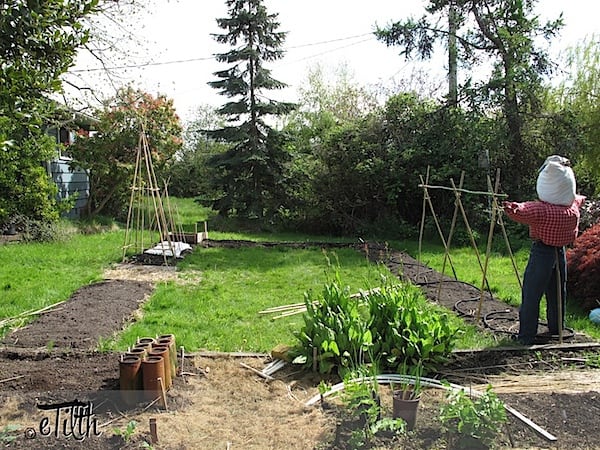
‘Fat Stanley’ surveying a failed keyhole garden layout, complete with encroaching blackberries, shade and an impossible watering configuration.
I won’t bore you with my epic failures – the pea-weevils, the tomato jungle, the post-vacation crispy garden, irregular and inefficient watering, arugula-haters, and a glut of beans (almost enough to fill one basket). None of my ‘crops’ produced sufficient amounts to achieve food-security; at best I could produce a meal. Let’s face it, I can’t realistically subsistence farm in my tiny vegetable garden.
The best estimates for self-sufficiency suggest one to two acres. I am the proud owner of a 150 square foot “farm”.
Last year, when I realized the insanity of trying to achieve impossible vegetable self-sufficiency, I reduced my vegetable garden by half in order to add straight, wheelbarrow-width paths for efficient compost rearrangement. Now I can get to the new chicken coop in the rain and pick chives for breakfast without full foul-weather gear. I grew lettuces, tomatoes and potatoes for the table, and put in dahlias and sweet peas for my soul.
I say it’s time to rethink backyard farming. No more unobtainable Urban Homesteading™, no mini farms, not even micro farms. Just growing what you can, growing what you love, and letting someone else do the rest.
Here are my top choices.
Tomatoes
There is nothing better than a home-gown tomato. But the best tomato is the one that doesn’t even make it into the house. It’s the one with the juice running down your kids’ cheeks, the sun-kissed candy you pop into your mouth one by one as you lay flopped on the lawn staring into the blue sky.
Forget trying to get 40 lbs of ‘Stupice’ or Roma tomatoes to ripen on canning day. Rely instead on bulk-buys organized by like-minded urban farmers. The Seattle Farm Co-op is my go-to group, or you can find one using the Local Harvest directory. That box of tomatoes that I put up as spaghetti, and spicy Indian masala sauce is long gone by February so I’ll need 80 lbs this year.
The delicious slicer tomato for your burger? Get a perfectly ripe heirloom from your Neighborhood Farmers’ Market instead. My favorite market is in Ballard because I shop on Sundays, but you can easily find others in your area through Local Harvest.
Can’t resist growing your own? Then hands-down, choose the cherry tomato, ‘Sun Gold‘. It is reliable in our climate, and never makes it into the house. It’s an indeterminate variety, so build it a trellis and let it climb, and remember that they won’t all ripen at once.
Lettuces
This is where you detailed, analytical types get to geek-out by planning succession crops and season extenders. For spring, start with ‘Forellenschluss’. You’ll also find this advertised as ‘Freckles‘, and ‘Flashy Trout’s Back‘, but it’s the same red-splashed lettuce.
I like this variety because you won’t find it at your grocery store, and probably not even your farmers’ market. Start seeds in mid-February on the windowsill, then transplant out with row covers in March (My sea-level Seattle garden has a last-frost date of April 4th). You’ll want to start three to four plants every two or three weeks in the spring (remember to be ruthless in discarding feeble starts). Sow this variety again in late July and August for your fall crop.
Follow the spring lettuce with ‘Jericho’, sowing in April-June. It’s a heat-tolerant variety of Romaine developed in Israel. It has good flavor and doesn’t taste ‘tough’. Because it is very upright in habit, you can use it as a cut-and-come-again variety. Start three to four plants every week to ten days in the summer.
Finally, in September and October, sow ‘Winter Density‘. It’s another Romaine type, with a tight head. The lower leaves won’t flop into the dirt and become slug-condos. This one should keep most of the winter under sturdy row covers, but plant six to eight plants because they grow more slowly in winter. High Mowing demonstrates the reemay-fleece with polythene high-hoop tunnel combination, but you can be successful with a fleece/low-tunnel version in your backyard.
- High Mowing Organic Seeds – Freckles
- High Mowing Organic Seeds – Jericho
- High Mowing Organic Seeds – Winter Density
Herbs
This is where the backyard garden will really excel, and maybe even make financial sense. Grocery-store herbs are expensive, and frustratingly, don’t stay fresh very long. Select herbs that you like and succession sow parsley, cilantro and chives in blocks every three weeks. I put radishes into this category because they mature so quickly, and you can inter-plant them among the lettuces. Sow as much arugula as you can; they’re better than sprouts on your sandwiches, no matter what your kids say.
Don’t bother with planting basil in the ground; it’s too cold here. Instead, buy one fresh $4.00 packet of basil at the grocery store. Gently snip off the bottom centimeter of each stem and the lower leaves. Put each stem in a jar of water on your windowsill, with the leaf junction below the water line, and it will form roots. Make sure to change the water at least weekly. You should be able to grow and eat that small purchase for many weeks.
Make the most of your vegetable garden space by tucking herbs into your flower garden, and save even more space by planting oregano, thyme, mint and rosemary in pots. Although they are tough, make sure they get adequate water.
Big Stuff
Potatoes
I really don’t recommend trying to grow space-hogging early-, main- and late-crop potatoes, or even my favorite Yukon Golds. These potatoes are reliably available at grocery stores and farmers’ markets. Instead, I grow Makah Ozette potatoes, a rare local heirloom potato that was available briefly until a crop failure, and is in danger of extinction.
The Makah Ozette potato is the only potato to be brought directly from Peru to Washington, and not via the Old World and back again. It has been grown in WA continuously for over 200 years. I bought a $7 sack from an independent garden center and continue to grow and save this unique potato. It has a thin bumpy skin and a delightful buttery flavor best enjoyed roasted, with a pinch of salt.
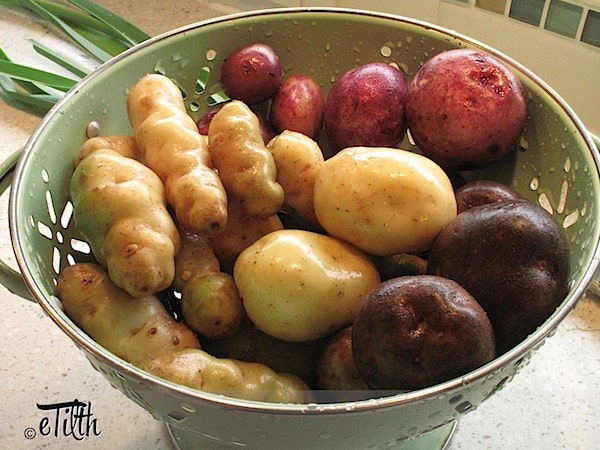
Bumpy Makah Ozette potato with Yukon Gold, Red and Purple Potatoes
Beans and Peas
Beans and peas can take over your garden. You can discuss the merits of bush and pole beans and purple-podded vs. green-podded, edible vs. shelling peas and you’ll never decide what is the best. In my opinion you can get shelled frozen peas with decent flavor at your grocery store, and delicious green beans at the farmers’ market.
Don’t bother trying to grow drying-beans … just get them in the bulk aisle. But, if you have to have a bean or a pea, choose one you can send your kids out to pick, and not mind if they don’t come back with any. I typically grow ‘Cascadia‘, a snap pea that you can eat directly off the vine. Plan on growing one up a tower with climbing Nasturtiums like red ‘Spitfire‘ or yellow ‘Moonlight‘. The spicy Nasturtium leaves and flowers can end up in your salads, you can even pickle the seeds.
Squash
Fugeddaboudit. You can’t grow a variety that isn’t available locally, and you really don’t have the space. Unless you put it in your weird stuff category.
Flowers
This is the part we forget, when we become subsistence farmers. No room for flowers, right, unless they are companion plants or medicinal? WRONG. The older I get, the more I realize that I have to grow for the soul, as well as for the stomach.
I cringe at the prices of flowers at the market. Instead, I urge you to plan a cutting garden, so that you can have 52 weeks of flowers on your table. Last year I grew dahlias for the first time in the vegetable garden and they were spectacular. I’m moving them into the mixed border this year, now that I know how much water and sun they need (lots of both, but with good drainage.)
I also have been growing a fragrant heirloom sweet pea variety ‘Black Knight‘ for several years. Seeds you’ll buy in a packet are called F1 and will be uniformly dark. The next F2 generation will show the variation in its parentage. I’m playing with some backyard breeding and marked the darkest stems with twist-ties and saved seeds. I’ll let you know what the F3 generation looks like. Sow the seeds in September and overwinter in a protected area, or just sow them right now. I’m sure you can find a fence post or trellis for these.
- Dan’s Dahlias – Dahlias
- Swan Island – Dahlias
- Log House Plants – Sweet Pea Black Knight
- Annie’s Annuals – Sweet Pea Black Knight
Weird Stuff
So I’ve discouraged you from planting the big stuff that takes over your yard, the stuff you can get from the store or bulk-buys. I’ve encouraged you to use alternative space like pots and your back hedge. You’re growing up trellises and over pathways. You’ve planned for succession crops and inter-cropping. You’re all set, right?
Did you leave any space for some weird stuff? You won’t grow as a gardener without epic failures. Try something you’ve never thought possible, like sweet peppers (in our maritime climate? yeah, right …), or something you’ve never heard of.
This year, I’m adding ‘Couve Tronchuda‘, or ‘Tronchuda Beira‘, sometimes known as Portuguese Kale. It’s an heirloom brassica similar to both cabbage and kale, with wide broad leaves I can use to wrap around rice and mushrooms.
Since I now LOVE kale, I’ll grow it next to my favorite ‘Nero di Toscana’ lancinato type. I first heard of this variety from an old BBC episode of The Victorian Kitchen Garden. Because it is a non-heading variety, I should be able to pick leaves as I need them, to add to winter soups. It is also known to grow well in mild winters.
Finally, I’m adding ‘Scorzonera‘. It’s a black carrot-like vegetable with the flavor of oysters or some say like artichokes, and I’ll roast it with parsnips or add it to soups. I’d never heard of it until I started watching historical gardening shows, but once I started looking, I realized Barbara Damrosch has already trialed it. She’s not a fraud. So at least I’ll be in good company.
- Johnny’s Seeds – Scorzonera
- Nichols Garden Nursery – Scorzonera
- Nichols Garden Nursery – Tronchuda
- Renee’s Seeds – Tronchuda
In summary
Let’s stop trying to grow it all and just focus our limited time and space on the highest reward options.
- Does it grow well here? Don’t bother with things that are too challenging. You don’t have enough space for crop failures.
- Is it available in stores? If so, then buy it there, and reserve your space for something special.
- Does it need to be in the vegetable garden? Tuck herbs into pots, plant chard in your border. Save space and grow things up trellises, over paths, and in hanging baskets.
- Do you need a lot of it? Let others grow it for you. Rely on bulk-buys and farmers’ markets.
- Try something new every year.
- Grow something to make you happy.

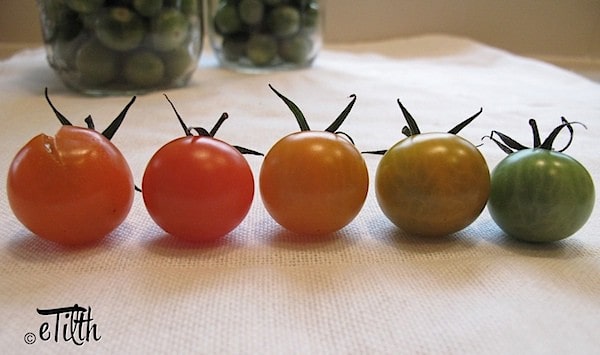
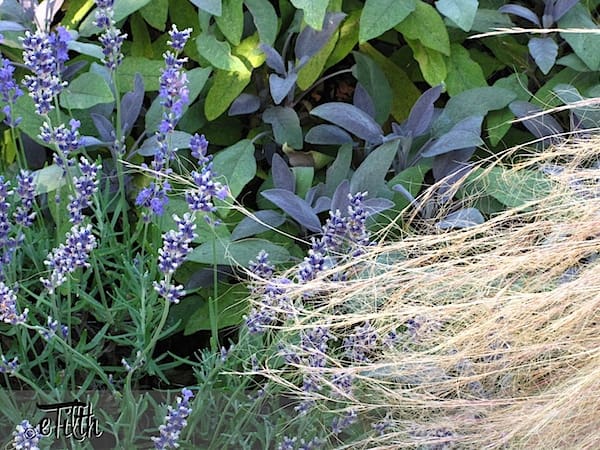
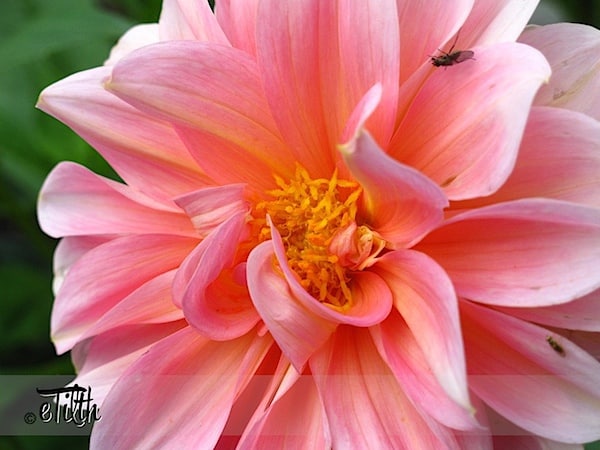
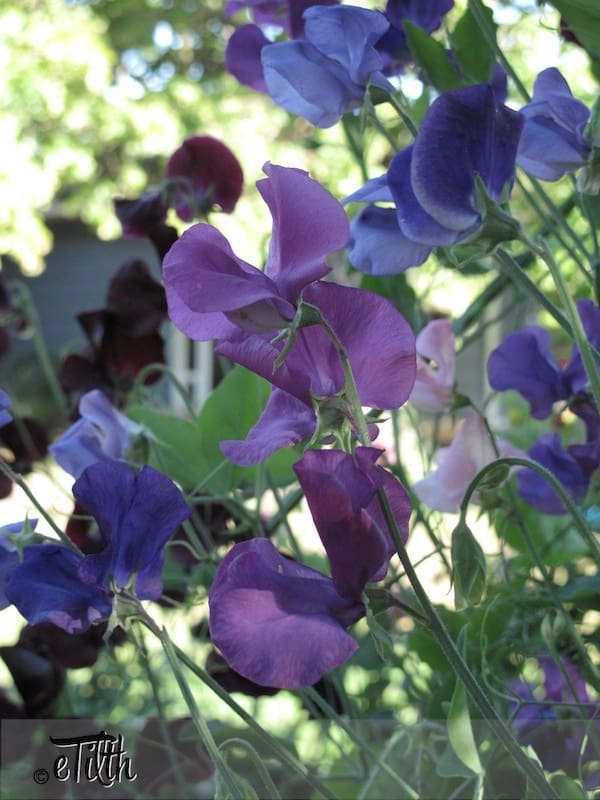
I loved this post–it rings so true. The first year (which was not that long ago), I knew nothing about gardening, except what I’d read on the internet–thank god for blogs and Pinterest. I somehow ended up with Sweet Baby Girl Tomatoes (SBGT) that took off like crazy and produced like mad. They were delicious and dried amazingly well. Was I satisfied with them? No–I decided I HAD to plant heirloom tomatoes, so the next year, I did. But, I also planted a few SBGT, cause, ya’ know, I had some leftover seeds. Heirlooms did so-so, but those SBGT again went nuts. The next year, same thing, only but with different heirlooms. By this time, I realized that, damn, I’m a sloppy-assed gardener. Weeds? Yep, they’re there. Plants in a straight line? What’s a straight line? Mulch? Oh, yeah…dump some of the grass mowed from the lawn. So, this past year, planted again those heirlooms, and threw in some SBGT. Only this year, thanks to my sloppy-assed gardening, there were SBGT plants volunteering all over my garden. Guess what? This year, more heirlooms and of course, my standby, those delicious and overly productive Sweet Baby Girl Tomatoes. I know loyalty when I see it.
I can’t believe how many tomatoes I planted one year … they grew up in a tangle that you could only harvest from the edges. I set my chickens on them and it was so funny to see them jumping up to get the tomatoes off the vine!
Then there was the towering pile of grass-clippings my husband kept bringing over, that I thought I was so clever using to mulch around the tomatoes. Can we say slug-heaven? And stinky? I suppose I *should* have carefully spread the grass on the patio to dry slowly, and then had my “staff” gently form artistic hay-ricks prior to using them as mulch, right?
Thank you so much. I thought I had given up gardening, but this makes me want to try again. As a disabled elder who splits time between the Northeast and Florida, it is more than difficult. But maybe in boxes and pots I can manage a few things. And a sunny corner might host just one Sun Gold. I can’t forget the year I ate handfuls all summer, dried bags and bags of tomato “raisins” and sent them away fresh with anyone who glanced at my garden.
Growing things, even just a few things, always brings me joy. I try hard not to beat myself up over the things I’m not growing. I travel during the summer in our trailer and fantasize about how we’ld do it full-time (how would I garden!?!) Lots of small pots of herbs, and maybe a small basket that can be changed out seasonally … go to the grocery store and get some primroses in spring, some petunias in summer, some grasses in fall, cyclamen in winter.
I too garden in a small home plot – about 140 sq feet, plus containers on the porch. While I attempt broccoli, zucchini, peas, etc., it’s the lettuce that I am able to produce on a large enough scale in a small enough space to feed my family all through the growing season. Salads with every dinner, from April to October… and the lettuce is just in containers on the porch and shoved in between my other “crops” in the garden. I am a firm believer that anyone with any skill level can grow a good amount of lettuce in a small space with very little effort. Thanks for your post… I hope you inspire others to set aside a few feet to grow.
Lettuce is very rewarding. It’s wonderful to be able to make at least one dish from your own garden, and to be able to do it all summer? Awesome.
Lettuce is my WATERLOO… It’s always just ok, when everyone else seems to think it’s as easy as falling off a log. What am I doing wrong?
Re pickling green Sungold cherry tomatoes: Ferment instead – they are delicious…….
Yes, I too have been carried away by the allure of the seed catalogs and the romantic notion of self-sufficiency. I think it’s kind of a rite of passage – you have to experience the failures to get to the point of being at peace with your garden space / climate zone / time commitment.
Not surprisingly, my idea of what’s worthwhile is subjective and different from yours. Potatoes? Hell, yeah. To me it’s just so satisfying to step into my backyard in February and dig up a perfect, fresh potato – one of the benefits of our PNW climate. Dry beans? Another resounding yes from this corner. They are so easy to grow, deal well with our dry summers, and can be picked and processed all at once. Plus they store indefinitely. Garlic is also one of my top favorites to grow – and this one even makes financial sense when you look at what a head of organic garlic goes for these days.
So I think you’re dead on that we need to re-evaluate our priorities once in a while. But also think about what it is that gives *you* the most satisfaction. It may be something completely different from the things mentioned here.
It is amazing what you can learn from screwing up! I just learned that leaving my un-scrubbed, dirt-encrusted, precious dahlias in a paper bag for just a few months in the cold potting shed is way too damp … can we say moldy? Sheesh, newbie mistake.
I’m delighted that you disagree with me about your essentials. I hope we’re neighbors; then we can trade!
Great Post! Made me laugh and made me think. Reminded me to not beat myself up so much about having to have everything perfect.
Nice post. Even though I have acres, much of this rings true. I buy peas at the supermarket. They are cheap, on the safe list when it comes to pesticides, and I can grow snap peas and snow peas in their place. I may have lots of space, I also have a less forgiving climate, way too many trees hogging the sun, and poor soil. It doesn’t seem to matter how much wonderful organic matter one ads, a year or two later it is gone. The motto in my gardens, both flower and veg, is “No Prima donnas”. Though I do stubbornly keep trying to grow cauliflower and squash. As for the heirlooms, those hybrids were developed for a reason. I highly recommend Erica’s excellent post on the difference between hybrids and GMOs. Many people get them mixed up. Also reading Steve Solomon’s chapter on the seed industry is an eye opener. While we have civilization, some things can be left to experts.
Two things that will always be in my garden… cucumbers and squash. I know, the squash takes up space, but I love, love, love seeing Delacata mature on the vine. Besides, they are two plants that I can grow well with no effort. In my yard, epic failures occur with tomatoes, peppers, onions, garlic, carrots… all things that I would really love to grow, but instead just buy because of the sad state of the plants when I try to grow them. Some flowers that I discovered last year and will always have: nasturtium, zinnia, calendula, and peonys. I’m trying rugosa roses this year, hoping for a dual crop… cut flowers and rosehips.
Thank you, Grace, for a well-written post (“Square Food” is what my kids said about broccoli, carrots, et cetera; Mel B.’s “Square Foot” system is the quintessence of Engineering Meets The Garden). I can hear Steven Covey’s Seven Habits here, too, with the clear metaphor of greater success through interdependence with others over total self-grown everything independence, both of which are better than being wholly dependent on others [those in the Entitlement Generation need not apply]. Very nice ideas given, beautiful photos, too. Mahalo.
Thank you for your kind words. I have only in the past few years learned that interdependence and community matter. Nothing like raising children to learn that!
We have found two weird/salad vegetables that take little space, are easy to grow, and “keep on giving”. They are Shungiku, an edible chrysanthemum and New Zealand spinach. Our garden is larger because we grow for our local farmer’s market but these two greens are wonderful and almost daily on our plates throughout the growing season. Both can be used fresh in salads (our norm) or cooked.
Thanks for the tip! I’ve never heard of Shungiku. I’m growing perilla/shiso this year because I love its flavor … too commonly used in my house to be considered weird this year!
I am literally laughing out loud…at myself. Hubs and I retired a little over a year ago and have been renovating a home – a work in progress – and battling the outside. Can you say Himilayan friggin’ blackberries? God, I hate those things! I had / have grandiose ideas of a special garden spot, so Hubs and I cut out and pulled up tons of blackberry roots and crowns, three old rhodies, and a variety of other crap too numerous too mention. Hubs built me a cute little picket garden fence with a cute little gate, with cute little dragonfly fencepost toppers. We laid down burlap. Found we actually needed to lay down more than one layer of burlap…picked that up yesterday….
Now, still have to build the raised beds (are you laughing yet?), plant my tomato seeds (did I mention I ordered the amount of seeds I ordered from High Mowing Organic Seeds?), and bring in my soil mix, compost, etc. Oh! And the ‘garden’ is so far away from the outside faucets, both front and back, THIS will be interesting!
Even with all that, and the realization that I’m out of my mind – I can NOT wait to play in the dirt! It’s okay. And I’m still as excited as I could possibly be….failure is not an option. because hey, if something doesn’t grow, I figure it just wasn’t meant to be anyway….or, I’ll try something else next time!
I can’t wait to hear about how you do! I recommend
1) get a goat for the blackberries. I borrow my neighbor’s goats.
2) Don’t let the aforementioned goats eat the rhododendrons … You can see the mess of blackberries and rhodies in my first picture, so I hear you – constant battle.
3) don’t bother with raised beds. Really. Just use the PhD approach: Piled higher and deeper. I edged my entire 150 sqft with bricks on the side, just to define the space, and I rearrange the rows this way and that, every year.
4) Irrigation is my biggest challenge, too. At present, I can water the garden with just one overhead sprinkler, placed just so, so that the chicken coop remains dry. But the hose keeps getting tripped over …
Google Bealtaine Cottage for pure inspiration and a daily lungful of clean air.
Go Portugal! Portuguese “couve”, is the best: much sweeter and more tender than most kale. We actually consider it more of a cabbage here, since kale, of us, is the ubiquitous walking-stick kale (google that for a laugh!). Be sure to cook and eat the stalks along with the leaves. They look daunting (“tronchuda” actually means thick-stemmed), but they’re the best part.
Another thing I’ve learned to do in a tiny garden is plant root crops with edible leaves–beets, turnip, radish–so that I can make mixed-greens stirfry while they’re growing (harvesting just one or two leaves from each plant at a time), and then use the roots and remaining leaves when they mature.
And I second the recommendation for New Zealand spinach. It’s the gift that keeps on giving. This year I’m using it as ground cover in my front garden and will “trim” as needed to eat…